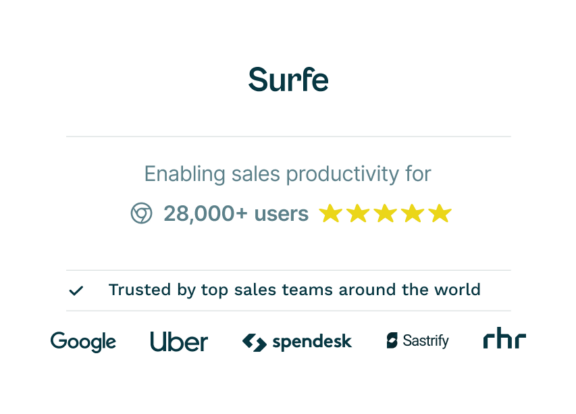How Cognitive Biases Impact Buying Decisions and How to Work Around Them
Remember the last time you put on a pair of tinted sunglasses?
You saw the world nearly the same as everyone else – just ever so slightly different. Maybe in a shade of yellow or orange, or blue if your style’s a bit more out there.
Cognitive bias is a little bit like that. It subtly changes the way you see everything around you without even realizing it. Just like the lenses of tinted sunglasses change the color of what you see, your brain shifts your decisions and perceptions based on hidden biases.
All this really comes down to is your brain trying to simplify information processing and decision making – but in some contexts, it’s not always that helpful. Prior experiences and expertise cause ‘errors’ that limit our ability to think divergently – which can be problematic if you’re – oh, we don’t know – trying to sell someone something new.
Understanding cognitive biases is crucial for sales professionals, as they’ll heavily influence your buyers’ decisions. That’s exactly what we’re going to dig into today:
- Common Cognitive Biases in Buying Decisions
- How Cognitive Biases Manifest in Different Stages of the Buying Process
- Practical Tips for Sales Teams to Counteract Cognitive Biases
By the end of this blog post, you’ll have all the knowledge and tools you need to not only understand cognitive bias, but actually use it to your advantage. In turn, you’ll experience smoother sales processes and close more deals.
If we could take a truly wild guess, we’d say that sounds pretty good to you. Let’s get started.
Common Cognitive Biases in Buying Decisions
Your first step towards working around cognitive bias is understanding the different ways it can show up in sales, and the different impacts it can make. Let’s take a closer look.
Anchoring Bias
Anchoring bias pops up when buyers rely too much on the first piece of information they receive. Any information that follows that up is interpreted from the initial reference point, instead of being seen objectively.
In sales, you might see this if an initial price given or product comparison made ends up driving conversations later down the line. This can be problematic if it stops your buyer from accepting a better or more appropriate deal, because their perception of value has already been anchored.
Let’s take an example. Imagine your buyer has a budget of $10,000 – but the first ballpark price they receive from you is $5,000. After several conversations, you come back to them with the most appropriate price for their needs: $8,000. The risk here is that their anchoring bias makes them see $8,000 as more than they need to spend – even if it’s below their initial budget.
If you’re not able to persuade them to go with your suggested option, you’re 1) missing out on $3,000 and 2) potentially causing problems later down the line when they realize the cheaper item doesn’t fulfill their needs.
A workaround here is to introduce a range of options early. With multiple reference points, your prospect isn’t going to rely on any one number.
Confirmation Bias
Confirmation bias is when buyers seek out information that confirms their pre-existing beliefs. It’s mostly unintentional – but causes people to ignore information that doesn’t fit in with what they think already.
In sales, this might look like a buyer favoring reviews or data that support their initial preference or perception of a product.
For example, say a buyer tries your product for free – and doesn’t find it super easy to use. They might then go on to ignore reviewers who say it’s a dream to use once you’ve had training, or that getting to grips with it is well worth the results.
This can be a tricky one, as it limits your buyer’s openness to better alternatives. We’d recommend providing balanced information from the start; making sure to address opposing perspectives, and building trust from the get-go. This is where a well-paced sales process comes in handy – it gives you plenty of time to address all three of these.
Bandwagon effect
Buyers are influenced by the actions or choices of others.
In sales, this means popular products or endorsements can lead buyers to follow trends – without assessing whether following this trend is a good idea for them. It can lead to impulsive decisions based on peer or social pressure rather than individual needs.
For example, if a buyer sees that every one of their competitors uses a specific tool, they might rush to buy it themselves. The problem here is that this tool may not work for their specific tech stack or needs, making it a poor investment. This could work either way for you, by the way. Maybe your buyer is really set on a competitor when you know your product would be better, or maybe they’re really set on your product but you’re not sure you’re the best choice for them.
To work around the bandwagon effect, make sure you emphasize unique selling points from the start. Focus on how the product addresses the buyer’s specific needs rather than relying solely on popularity.
Loss Aversion
Buyers fear losses more than they value equivalent gains. This is because the emotional impact of a loss is felt more intensely than the joy of an equivalent gain.
In your day to day, this might look like a buyer hesitating to make a decision or switch vendors, due to a fear of potential downsides. Worst case, they might stick with their current solution – even if it’s really not working.
Your way around this is to position the decision as a way to avoid future losses, rather than just a way to make potential gains.
The Halo Effect
You can think of the halo effect as the impact a brand’s reputation has on a buyer’s impression. This can work in your favor, or…not so much in your favor.
For example, if you have an excellent brand reputation you’re on the money. Buyers are more likely to overlook product shortcomings based on their overall impression (not that we’re implying you have any shortcomings, but you get our point). On the other hand, if something goes wrong – like a data leak or a piece of bad press – and your brand suffers, buyers might ignore the fact your solution is perfect for them.
To avoid irrational decisions based on overall brand perception, focus on presenting factual, feature-specific details to guide buyers toward a more informed decision.
How Cognitive Biases Manifest in Different Stages of the Buying Process
If all these different types of cognitive bias sound like a lot to work around, don’t worry. It’s unlikely they’ll all pop up at the same time. Instead, you’re far more likely to be handling different cognitive biases at different points in the process:
Initial Research and Awareness
When your prospect’s just starting to hear about you, they’re likely to experience confirmation bias and anchoring bias. First impressions are important here. You need to set the tone from the start; making sure they’re seeing the full picture.
To nail this section, deliver diverse, fact-based content in the early stages to reduce their reliance on first impressions.
Evaluation and Comparison
When your prospect’s weighing up your product and checking out competitors, they’re likely to experience the bandwagon effect and loss aversion. You might even see both at the same time – a fear of missing out by not going with the most popular feature or product, for example.
Case studies and testimonials provide a balanced view (and may even make the bandwagon effect work in your favor 😉). Don’t avoid alternatives – present them clearly to reduce the chance of any irrational decisions.
Final Decision and Commitment
When it comes to the final decision, buyers might still experience loss aversion – and the halo effect may come into play too. Loss aversion here could look like concerns about price, while the halo effect could swing the decision one way or another.
Reassure the buyer by minimizing perceived risks. Guarantees or free trials are a handy tool to have up your sleeve if you need to.
Practical Tips for Sales Teams to Counteract Cognitive Biases
Ok, so now you know what cognitive biases to look out for and where you’re most likely to come across them. Next up – top tips on how you can stop cognitive biases in their tracks.
Educate Buyers Gradually
Basically, you want to reduce the buyer’s reliance on their biases and assumptions. At the same time, though, you don’t want to overwhelm them with so much information they revert back to what they thought in the first place.
Provide structured, digestible content that builds the buyer’s knowledge and reduces reliance on biases. Drip email campaigns, blog posts, and whitepapers can offer valuable insights over time.
Personalize Your Approach
If your buyer has a perception of your product based on what other people are saying or doing, you need to change it – stat. Tailoring your messaging to each buyer’s unique needs will do the trick here, as it gets them to start thinking about what you can do for your business.
Your CRM will come in handy here – set it up to track buyer preferences and share personalized product solutions.
Encourage Critical Thinking
Ok, we realize we sound a bit like a teacher here, but you can encourage your buyers to move away from their biases when they’re making a decision. Open-ended questions encourage buyers to consider what they really think and what other perspectives are out there.
Encourage them to reflect on their current solution’s shortcomings and the benefits of alternative solutions to point them in the right direction.
Create a Sense of Urgency without Manipulation
Deadlines or limited-time offers are a reverse Uno, if you will – they encourage the buyer to avoid loss aversion and take the deal.
Obviously, we don’t encourage manipulating your customer (apart from anything else, it will come back and bite you) but highlighting what the buyer might miss out on and focusing on long-term benefits is a goodie here.
Metrics to Measure Success in Addressing Cognitive Biases
As always, you want to make sure that you’re addressing cognitive biases correctly. There’s no point in, say, creating a sense of urgency if it causes two out of three prospects to run for the hills. Here’s what we recommend keeping an eye on:
- Sales Cycle Length: has the time from lead to conversion shortened now you’ve adopted these techniques? If you answered yes, you’re doing it right.
- Conversion Rate: keep an eye on increases or decreases in closed deals – an increase shows you’ve managed them effectively.
- Customer Satisfaction (Post-Sale): measure satisfaction to see if overcoming biases leads to better-aligned purchases. Over time, you’ll also see improved retention rates here.
- Response Time to Inquiries: keep your responses lightning-fast, and you’re reducing confirmation bias that might creep in as they wait around.
Let’s Wrap It Up!
Hey – those glasses look good on you!
By now, you should understand that cognitive bias isn’t always a bad thing – the key is being aware of what it is and when it might show up in the process. From there, you can either use it to your advantage or make sure you’re offsetting it with helpful advice and content.
Keep the impact of your prospects’ cognitive bias low, and you’ll see your sales cycles shorten and the amount of sales you make increase. Not that we’re biased, or anything.

Ok, we really promise we’re not biased…
…buuuut, Surfe is an epic tool to add to your box. We promise – give it a go for free.
FAQs About How Cognitive Biases Impact Buying Decisions and How to Work Around Them
What Are Cognitive Biases And How Do They Impact Buying Decisions?
Cognitive biases are mental shortcuts that influence how we process information and make decisions. In buying situations, these biases can lead prospects to make irrational choices, favor familiar brands, or choose products based on emotions rather than logic. For example, biases like the Anchoring Bias can make a final price seem less attractive if the first price seen was lower – even if both are within budget.
How Can Sales Professionals Work Around Cognitive Biases To Improve Sales?
Sales pros can work around cognitive biases by understanding them and creating strategies that guide customers toward better decisions. Techniques like gradual education, offering social proof, or creating urgency can leverage biases in a positive way. Transparent, value-driven information can also help counteract biases, making sure your prospects make the best decision for them – and for you.









